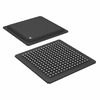Manufacturer Part Number
ADSP-21062CS-160
Manufacturer
Analog Devices
Introduction
The ADSP-21062CS-160 is a high-performance digital signal processor from Analog Devices' SHARC® series.
Product Features and Performance
Floating Point architecture
Host Interface, Link Port, Serial Port for versatile connectivity
Clock Rate of 40MHz for efficient processing speed
On-Chip RAM of 256kB for rapid data access
Support for External Non-Volatile Memory
Surface Mount, 240-BFQFP Exposed Pad package
Suitable for operation in extreme temperatures from -40°C to 100°C (TC)
Product Advantages
High integration reduces system cost and complexity
Excellent computation power for real-time digital signal processing
A broad range of interface options for system flexibility
Robust temperature range for high-reliability applications
Key Technical Parameters
Interface: Host Interface, Link Port, Serial Port
Clock Rate: 40MHz
On-Chip RAM: 256kB
Voltage - I/O: 5.00V
Voltage - Core: 5.00V
Operating Temperature Range: -40°C ~ 100°C
Quality and Safety Features
Quality ensured by Analog Devices' manufacturing standards
Meets rigorous testing for operation within specified temperature ranges
Compatibility
Supports various external memory options for system design flexibility
Can interface with other devices through Host, Link, and Serial Ports
Application Areas
Industrial control systems
Telecommunications
High-end audio processing
Avionics
Medical instrumentation
Product Lifecycle
Obsolete status indicates end-of-life with limited availability
Potential availability of replacements or upgrades with newer DSP models from Analog Devices
Reasons to Choose This Product
Proven SHARC® series DSP for reliable signal processing
Floating Point precision handles complex algorithms with accuracy
Striking balance of performance versus power consumption at 40MHz clock rate
Adequate on-chip memory accommodating significant real-time data processing
Environmental resilience with wide operating temperature range
Readily adaptable to a variety of applications due to the extensive interfacing capabilities



 ADSP-21062LCS-160Analog Devices
ADSP-21062LCS-160Analog Devices ADSP-21062KB-160
ADSP-21062KB-160